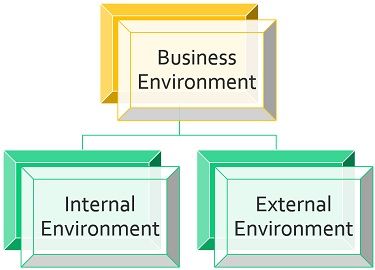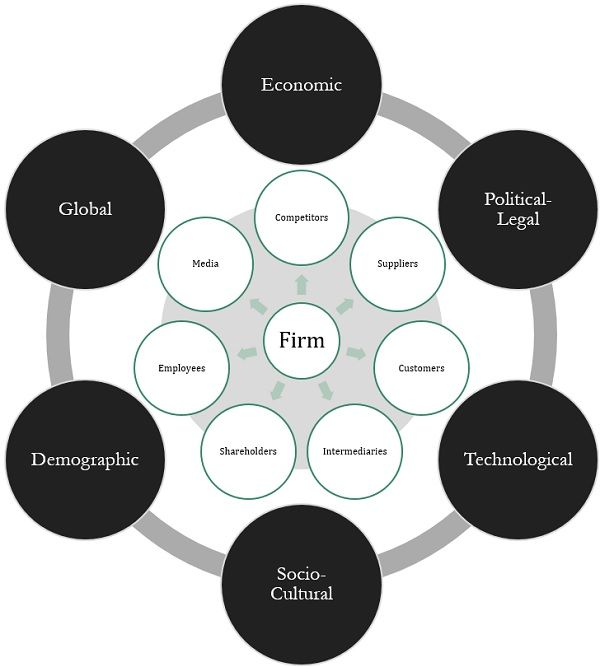 Internal Environment pinpoints in-house factors of the firm, which are often constitutional in nature. On the flip side, External environment is composed of those factors which are exterior to the firm.
Internal Environment pinpoints in-house factors of the firm, which are often constitutional in nature. On the flip side, External environment is composed of those factors which are exterior to the firm.
Business refers to the collective effort of the firm in making money by buying and selling merchandise. We all are aware of the fact that every business operates in an environment called Business Environment. The business environment comprises all the elements that have a bearing on the decisions, moves and functions of the business.
The environmental factors, not just affect the business, because of the changes and activities, but these factors can also be affected by the business activities. Based on the extent of control, the environmental factors are divided into two groups or say types – Internal Environment and External Environment. So, let’s start our discussion on the difference between this two environment.
Content: Internal Environment Vs External Environment
Comparison Chart
| Basis for Comparison | Internal Environment | External Environment |
|---|---|---|
| Meaning | Internal Environment refers to all the inlying forces and conditions present within the company, which can affect the company's working. | External Environment is a set of all the exogenous forces that have the potential to affect the organization's performance, profitability, and functionality. |
| Nature | Controllable | Uncontrollable |
| Comprise of | Strengths and weaknesses | Opportunities and threats |
| Affects | Company only | All companies operating in the industry |
| Bearing on | Business Strategy, functions and decisions | Business survival, growth, reputation, expansion, etc. |
Definition of Internal Environment
Internal Environment is that part of the business environment which is concerned with the different factors present within the organization. It comprises of conditions, forces, members and events which has the capability to influence the company’s decisions and operations.
It determines the procedures and methods in which activities are carried out in the organization, as well as it includes all of the immediate and information resources, such as technical, financial and physical resources of the organization. These factors are:
- Value System: Value system can be defined as a set of rules and the logical and consistent values adopted by the firm, as a standard guide, so as to regulate the conduct in any type of circumstances.
- Vision, Mission and Objectives: Vision refers to the overall picture of what the enterprise wants to attain, whereas mission talks about the organization and its business, and the reason for its existence. Lastly, objectives refer to the basic milestones, which are set to be achieved within the specific period of time, with the available resources.
- Management structure and Internal Power Relationship: Management structure implies the organizational hierarchy, the way in which tasks are delegated and how they relate, a span of management, relationship amidst various functional areas, the composition of the board of directors, shareholding pattern and so forth.On the other hand, internal power relationship describes the relationship and cordiality between the CEO and board of directors. Further, the degree of support and contribution received from the employees and other members of the organization strengthens the organization’s decision making power and its organization-wide implementation.
- Human Resource: Human resources are the most important asset of the organization, as they play a critical role in making or breaking the organization. The skills, competencies, attitude, dedication, morale and commitment, amounts to the company’s strengths or weakness.
- Tangible and Intangible Assets: The tangible assets refers to the physical assets which are owned by the company such as land, building, machinery, stock etc. Intangible assets amount to the research and development, technological capabilities, marketing and financial resources etc.
Definition of External Environment
External Business environment comprises of all the extrinsic factors, influences, events, entities and conditions, often existing outside the company’s boundaries but they have a significant influence on the operation, performance, profitability and survival of the business enterprise.
For the purpose of continuous and uninterrupted functioning of the business, the enterprise has to act, react or adjust according to these factors. These factors are not under the control of the enterprise. The elements of the external environment are divided into two categories:
Micro Environment
Otherwise called as task environment, these factors directly influence the company’s operations, as it covers the immediate environment that surrounds the company. The factors are somewhat controllable in nature. It includes:
- Competitors: Competitors are the business rivals, which operate in the same industry, offering the same product and services, and cater to the same audience.
- Suppliers: To carry out the production process, the raw material is required which is provided by the suppliers. The behaviour of the supplier has a direct impact on a company’s business operations.
- Customers: Customers are the target audience, i.e. the one who purchases and consumes the product. The customers are given the most important place in every business, because, the products are created and promoted for customers only.
- Intermediaries: There are a number of individuals or firms that help the business enterprise in the promotion, selling, distribution and delivery of the product to the end buyer, which are called as marketing intermediaries. It includes agents, distributors, dealers, wholesalers, retailers, delivery boys, etc.
- Shareholders: Shareholders are the actual owners of the company, as they invest their money in the company. They get their share in the profits also, in the form of a dividend. In fact, they have the right to vote at the company’s general meeting.
- Employees: Employees refers to the company’s staff, who are hired to work for the company to help the company reach its mission. Therefore, it is very important for the firm, to employ the right people, retain and keep them motivated so as to get the best out of them.
- Media: Media plays an important role in the life of every company because it has the capability to make the company’s product popular overnight or it can also defame them, in just one go. This is due to the fact that the reach of media is very large and so every content which is going to air on any form of media can affect the company positively or adversely depending on what kind of information it contains.
Macro Environment
Otherwise called as general environment, macro environment affects the entire industry and not the firm specifically. That is why these factors are completely uncontrollable in nature. The firm needs to adapt itself according to the changes in the macro-environment, so as to survive and grow. It includes:
- Economic Environment: The economic conditions of the region and the country as a whole has a significant bearing on the company’s profitability. This is because the purchasing power, saving habits, per capita income, credit facilities etc. depends greatly on the country’s economic conditions, which regulates the demand for the company’s products.
- Political and Legal Environment: The political and legal environment consists of the laws, rules, regulations and policies which the company needs to adhere. The changes in these laws and government may affect the company’s decisions, open doors of new opportunities for the business or pose a threat to the business.
- Technological Environment: Technology is ever-changing, as everyday a new and improved version of something is launched which is created with the state-of-the-art technology.This can be a plus point if the company is the first mover in the race, subject to the success of the product. However, if it turns out as a failure, it will prove as a wastage of time, money and efforts. Further, every company has to keep itself updated with the changing technology.
- Socio-Cultural Environment: Socio-cultural environment consist of those factors which are concerned with human relationships such as customs, traditions, beliefs, values, morals, tastes and preferences of the society at large. The company must consider these factors on various matters such as the hiring of employees, advertising the product and service, decision making etc.
- Demographic Environment: As the name suggests, the demographic environment covers the size, type, structure, education level, and distribution of population in a geographical area. The knowledge of this environment will help the firm in deciding the optimal marketing mix for the target population.
- Global Environment: Due to liberalization domestic company’s can offer their products and services for sale to other countries. In fact, there are many companies which are operating in a number of nations worldwide.Hence, such companies have to follow the laws prevalent in these countries as well as they have to adhere to international laws and guidelines. Further, the responses and the company’s norms must be in alignment with the global environment
Key Differences Between Internal and External Environment
The difference between the internal and external environment can be drawn clearly on the following grounds:
- The internal environment is composed of all those factors, events, conditions, etc. which exist inside the company and has the capability to influence the company’s strategic decisions and functions, as well as they can be influenced by company’s decisions.On the contrary, the external environment is that part of the business environment consisting of all those factors which do not exist within the company but can affect the company’s operations, decisions, survival, growth and profitability.
- Internal environmental factors are controllable in nature, in the sense that the company has supremacy over these factors. Conversely, external environmental factors are largely uncontrollable in nature.
- Internal environmental factors, either impart strength or cause weakness to the firm. As against, external environmental factors either give opportunities or poses threats.
- Changes in internal environmental factors affect the company only, as the factors belong specifically to the company. In contrast, changes in external environmental factors have an impact on the industry as a whole and so all the companies operating in the industry gets affected by it.
- The internal environment consists of those factors which have the potential to influence the company’s decisions, working and strategies. On the flip side, the external environment comprises of those factors which can affect the survival, growth, reputation and expansion of the company positively or negatively.
Conclusion
The company has to properly understand the business environment, i.e. the internal and external environment, in which it operates, so as to survive and function smoothly. It will also help in its growth and expansion in the long run.






Zephania matwiga says
Ilike this notes
winfrida kipesha says
i like also too
Nedson says
So helpful! I like them too
Amazenesia says
very nice info
Trial Techno says
thanks for sharing